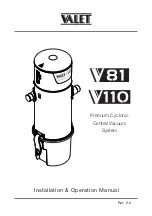
11
CLOG REMOVAL
Clogs in the Airflow Pathway - Figure 24
Most clogs can be removed by accessing the airflow pathway via the orange col-
ored access door (54) located on the underside of the power head. However,
other clogs may only be removed by accessing the airflow pathway by disas-
sembling the machine in the opposite sequence of the machine’s original
assembly (see assembly, page 7).
Clogs in the Attachment Hose - Figure 25
Blockages in the hose can be cleared by removing the attachment hose (16)
from the machine by squeezing the retaining ring (3) and inserting the opposite
end of the hose in the connecting tube (39). Hold the hose upright with one hand
blocking the top end and switch on the machine. If necessary, quickly lift your
hand on and off the end of the hose. If this procedure does not clear the clog, a
straight wire can be inserted into the hose to push out the clog. Take care not
to puncture the hose with the wire.
Clogs in the Attachment Tube (Active Wand) - Figure 26
Remove attachment hose (16) from the attachment tube (6) by pressing the
hose release button (38). Then, grip attachment tube handle (2) and remove
tube from the machine. A straight wire can be inserted into the tube to push out
the clog.
Clogs in Entrance to Dust Bag - Figure 27
Remove the attachment hose (16) from vacuum cleaner (see figure 26) and remove
the dust bag housing cover (24). Clean out the connecting tube and/or entrance to
bag (55).
Clogs in the Swivel Neck - Figure 28
Remove the dust bag housing from the power head by pressing the release but-
ton (28). Lift upward firmly and evenly to properly remove the dust bag housing.
Then, release the foot pedal (27), lower the swivel neck (32) and clean out the
pathway.
2
CHE
CK
BR
USH
ON
/O
FF
Figure 28
Figure 25
Figure 24
Always unplug vacuum from outlet before removing
any clogs!
!
Figure 27
Figure 26
16
6
2
38
54
3
39
55
28
32
27


































